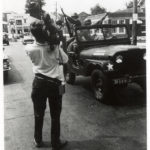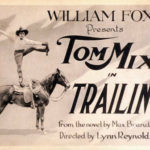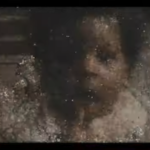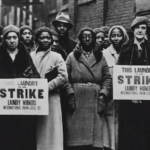The Fan Edit: What Do You Mean, It’s Not Our Film?
If you object to the way a director or studio revises a film you particularly like, and the original is not readily available, why not recreate the original and distribute it among fellow enthusiasts?
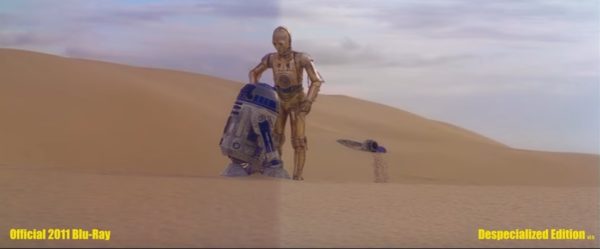 All you need to do is to stitch together the original from available elements, and probably spruce them up digitally into modern, high-tech shape.
All you need to do is to stitch together the original from available elements, and probably spruce them up digitally into modern, high-tech shape.
The film’s producers will likely have issued the revised version on DVD and Blu-ray, so you can grab bits and pieces of the original, from those. Some sections of the original will likely be available only on moldering, low-quality, and perhaps very hard-to-find old VHS-tape releases.
That kind of improvised solution would hardly be approved, under copyright law, so one would hardly recommend it, but it’s an approach that some die-hard fans have undertaken, frustrated that approved channels do not provide them with their favorite unrevised versions of films — or even, films edited in ways they’d prefer.
This is the world of the “fan edit,” in which fans modify films to make them fit their own preferences. That might take the shape of removing or altering scenes or dialogue, or even placing deleted or unused scenes into producers’ finished products.
Back in 2000, for example, professional film editor Mike J. Nichols, going by the title “Phantom Editor,” modified the original Star Wars film, cutting or altering things he didn’t like about it, and released his version as The Phantom Edit. (As we shall see, Star Wars has been a repeated focus of fan-edit attention.)
In 2002, DJ Hupp “fixed” — to his liking — the commercially released A.I. Artificial Intelligence. Hupp, an independent filmmaker, didn’t like the way Steven Spielberg had completed the film after Stanley Kubrick died, so he re-edited and released The Kubrick Edit in a style that he considered more Kubrick-like.
In 2003, the Purist Edit attempted to align The Lord of the Rings: The Two Towers more closely with J. R. R. Tolkien‘s novels.
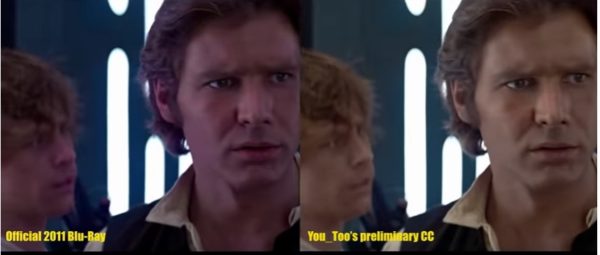 More recently, a certain “Dr Sapirstein” has knit together the two Kill Bill films of Quentin Tarantino to make an “ultimate edition,” — Kill Bill: The Whole Bloody Affair, complete with cut scenes reinserted.
More recently, a certain “Dr Sapirstein” has knit together the two Kill Bill films of Quentin Tarantino to make an “ultimate edition,” — Kill Bill: The Whole Bloody Affair, complete with cut scenes reinserted.
So things have gone, in fan-edit land. “If you did a deep dive into YouTube, there are probably million of hours of this content, if you had a pretty liberal definition of what a fan edit is,” says Jimi Jones, a doctoral candidate in library and information science at the University of Illinois at Urbana-Champaign. He says the practice offers some provocative teaching moments for instructors of courses on film archiving such as he teaches; more on that, below.
Many blockbusters have received fan-edit treatment, including The Matrix series, Dune, and Terminator 3: Rise of the Machines. Filmmaker Steven Soderbergh clearly believes in the practice, because on his website he has made available his edits of Psycho, Heaven’s Gate, 2001: A Space Odyssey, and Raiders of the Lost Ark. But the phenomenon is by no means limited to big-bucks releases.
The fan edit: a growing phenomenon
Like the video essay, in which film critics, scholars, and amateurs use material from DVDs and other sources to create video packages of their reflections on film and films, the fan edit is a phenomenon that likely will grow as low-cost technological means become available, but for now it requires considerable skill, ingenuity, and particularly determination.
That’s apparent in the case of Star Wars: Despecialized Edition. In that title, the word “despecialized” is key. The edition was created by some particularly driven admirers of Star Wars of 1977 and the two follow-up films that by 1983 completed George Lucas’s original Star Wars Trilogy. The fans were bothered by the various ways in which Lucas altered his original versions when he issued a series of “Special Editions” during the decades after the original films’ releases — “special” editions that he insists became the films’ definitive versions.
As followers of the Star Wars franchise will generally know, Lucas made significant changes to the originals, and some elements of the reissues were not as well technically produced as might have been expected.
Some of the changes involved plot elements. For example, when Han Solo is confronted in the Mos Eisley Cantina by an antagonist, Greedo, the original has Solo shoot first, while the revised edition has him fire only in seeming self-defense.
Among other added effects and footage was a scene involving Han Solo (Harrison Ford) and crime lord Jabba the Hutt.
Plenty of fans prefer the originals, but throughout the complex history of the franchise’s revised editions, with multiple DVD and Blu-Ray packages, Lucas has refused ever to authorize a release on DVD or Blu-Ray of the 1977 original Star Wars.
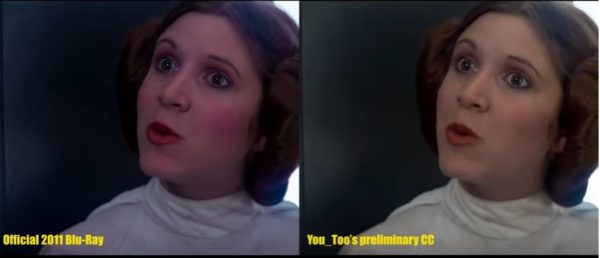 He has been quite insistent, even obstinate, about the issue. The National Film Preservation Board might have seen fit to place the 1977 Star Wars on the National Film Registry in 1989, guaranteeing it permanent preservation, but Lucas has never sent a copy of the original film to the Library of Congress, which oversees the program.
He has been quite insistent, even obstinate, about the issue. The National Film Preservation Board might have seen fit to place the 1977 Star Wars on the National Film Registry in 1989, guaranteeing it permanent preservation, but Lucas has never sent a copy of the original film to the Library of Congress, which oversees the program.
He once told the Associated Press that, as far as he was concerned, the 1977 original was “half a completed film,” so fans can like the revisions, or lump them; he didn’t care. “I want it to be the way I want it to be,” he said.
He added: “I wanted to actually finish the film the way it was meant to be when I was originally doing it,” and the original “only came out to be 25 or 30 percent of what I wanted it to be.” He had often been “disappointed” and “unhappy” about what had been “a dismal experience,” he said.
The original, whether still available on VHS or not, “doesn’t really exist anymore,” he said at the time (in 2010).
Still, plenty of fans persisted in preferring the originals. What were they to do, when Lucas was adamant that he would never make commercially available a high-quality DVD or Blu-ray edition of what became, by 1983, a Star Wars trilogy?
Re-create the originals, of course. The technological capabilities had become available that would permit skilled technicians to do that — amateur or professional — and to distribute the results, themselves, as a “despecialized” version. During a succession of releases of their restorations, the amateur producers have used peer-to-peer networks to download their versions and associated art work.
And, given Lucas’s stance, why even ask him for approval?
That was the origin of Star Wars: Despecialized Edition, a reconstruction of the theatrical releases of the Star Wars original trilogy (what became known as the series’ episodes IV, V, and VI) in high-quality versions. It has largely been the work of one enthusiast, a Czech school teacher and amateur (but clearly technically proficient) film producer who goes by the moniker “Harmy.” After his release of his Despecialized Edition of Star Wars in 2011, he went on to create similar recreations of the original The Empire Strikes Back [Episode V] and Return of the Jedi [Episode VI].
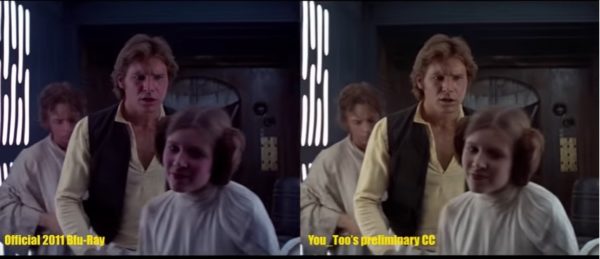 Harmy and fellow enthusiasts, who maintain an active online presence, make a variety of claims for the merits of the reissues. To create them, they compiled materials from various sources, such as VHS tapes, commercially available “Special Edition” Blu-rays, bonus DVDs with original Star Wars film sequences, digital television broadcasts, and scans of small-gauge film prints.
Harmy and fellow enthusiasts, who maintain an active online presence, make a variety of claims for the merits of the reissues. To create them, they compiled materials from various sources, such as VHS tapes, commercially available “Special Edition” Blu-rays, bonus DVDs with original Star Wars film sequences, digital television broadcasts, and scans of small-gauge film prints.
Lucas’s 2004 revisions for DVD releases, and again his 2011 Blu-ray set, they noted, had a variety of problems. Among them:
- “crushed blacks,” which is to say: blurring of dark images into undifferentiated blobs of black, making it difficult to see, for example, the outlines of Darth Vader;
- “heavily altered color palette,” making images murky that had originally been crisp and bright;
- “a slightly artificial look of some scenes,” the result of an automated digital cleanup.
According to explanations Harmy and co. have posted online, in various places, they were able to use a variety of methods in their efforts to overcome such problems. For example, one member of the group originaltrilogy.com conducted a digital color cleanup of “some of the worst issues of the 2004 master” (a print used for a 2004 official DVD release) using a well-preserved Technicolor print.
Holding to a “head canon”
As Jimi Jones tells students in his courses at the University of Illinois, the fan editors hold to what they call a “head canon.” They have said to themselves: “There’s a canon for this film or this franchise in my head and I want to make the film that I’m watching conform to that; so I start noodling around and cutting this out and so forth.”
In an article this year in The Guardian, Mikaella Clements noted that fan adaptations of the Star Wars: Despecialized Edition variety are hardly new. Take, for example, Virgil’s continuation in the Aeneid, 2,000 years ago, of Homer’s account in the Iliad and Odyssey of the legend of Aeneas. Or, consider Shakespeare’s retelling of Arthur Brookes’s 1562 The Tragicall Historye of Romeus and Juliet.
But “fan edits” hark more closely to “fan fiction” of the modern era, which even has a particular variety called slash fiction in which fans create sexualized — typically, same-sex — variants of popular figures in fiction and film. The 1974 story, “A Fragment Out of Time,” about forbidden love between Kirk and Spock, got that ball rolling.
Just as such fictions fascinated scholars of popular culture in the 1970s and 1980s, fan-edit films are fodder for courses in audiovisual restoration and preservation, says Jimi Jones. In a course he has taught for several years at the University of Illinois, he asks his students to note that the generally amateur auteurs of fan edits, in pursuing “head canon,” often employ just the skills that the students need to master. Take Harmy, for example. “My understanding,” says Jones, “is that he’s a kind of amateur archivist. He has a really impressive knowledge of color, space, and digital video and film color and film grain. It’s the kind of thing that we archivists take a long time learning in order to do the kind of work we do.”
What is “authentic”?
Just as interesting, he suggests to his students, is that fan edits raise an issue they will often confront: what is “authentic” when it comes to preserving films and other artistic products?
It was from this question that Jones became interested in fan edits, he says — interested enough that he presented a paper about them at the 2015 annual convention of the Association of Moving Image Archivists. He says: “I had taken a class on concepts of authenticity, in the arts, particularly in the rare books and manuscripts world: What is the authentic artifact?
“I thought it would be interesting to take some of these concepts out into the time-based media world, which is where I come from: I’ve been a filmmaker and archivist for 15 to 20 years, now, and I knew about Star Wars Despecialized. I like Star Wars; I’m a fan of the film, and I thought, well, there’s something here.”
It only made for a more compelling case study that Star Wars Despecialized was made by “this community that is negotiating what the authentic version of Star Wars is against the express wishes of the person who is nominally the creator, George Lucas.”
“Nominally,” because a film, while it might be attributed to a particular person, is always a collaborative effort, involving director, actors, cinematographers…
 In his course, says Jones (right), “we talk about concepts of authenticity, but we also talk about the moment that we live in, which is a time when the technologies for film and video preservation are available on the desktop for a lot of people, whereas what we did 20 years ago was very cloistered. The technologies for digitization and telecineing were very difficult to get a hold of, and only a few people were doing it; but now you’ve got a time when a lot of people are doing it, and it means, or it could mean that films, as kinds of artifacts, have a certain kind of interpretative flexibility not just in terms of what people think when they view them, but also how they preserve them and what they choose to preserve.”
In his course, says Jones (right), “we talk about concepts of authenticity, but we also talk about the moment that we live in, which is a time when the technologies for film and video preservation are available on the desktop for a lot of people, whereas what we did 20 years ago was very cloistered. The technologies for digitization and telecineing were very difficult to get a hold of, and only a few people were doing it; but now you’ve got a time when a lot of people are doing it, and it means, or it could mean that films, as kinds of artifacts, have a certain kind of interpretative flexibility not just in terms of what people think when they view them, but also how they preserve them and what they choose to preserve.”
“Guerilla archiving,” to a point
There’s a limit to how far one can press the “guerilla archiving” metaphor, Jones says; for starters, “they’re doing things that we would not do, ethically.” But still, fan edits are compelling, and part of the interest inevitably is that they’re undertaken sub rosa — “because obviously the American copyright regime is resistent to this,” as Jones says. “You can’t sell the stuff and I don’t think they even want to sell it, and that’s interesting to me, also. People aren’t trying to make money off of this; they’re just doing it because they believe that these more perfect or more authentic versions of these films should be out there.”
A typical statement posted with fan edits is this seemingly hopeful one, from Dr. Sapirstein’s Kill Bill package: “This is an unofficial non-profit release, created for criticism and research. It falls under the copyright act of 1976, 17 U.S.C., section 107. It is not to be sold or manufactured. We do not have any financial interests. We do not support piracy. Please respect the rights of the copyright holders. To have this version, you must own an original, unaltered retail version. By downloading this, the downloader assumes all responsibilities thereof as well as all the consequences that may incur and are hereby warned that downloading such a release might be illegal in their country.”
Such posters think, says Jones: “‘Warner Brothers ain’t gonna do it, George Lucas ain’t gonna do it… So we’re going to do it, ourselves.’”
In some ways, Jones suggests, “they are obeying a lot of our archival impulses, because as archivists, we are committed to the historical record and preserving people’s voices, and preserving artifacts, and so forth.” And again, he says, fan edits are taking place in “a kind of socio-technical moment” where the means of creation and distribution have evolved to permit guerilla participation.
Lucas may have unwittingly encouraged fan edits of his films — his responses to fans’ desires for his original films seem at odds with some earlier stances. Back in the late 1980s, he disparaged Ted Turner for colorizing the MGM library of classic films. Lucas addressed Congress in 1988 to decry Turner’s short-lived, ultimately unpopular practice, arguing along with many fellow filmmakers for the importance of preserving films in their original state.
He characterized “people who alter or destroy works of art and our cultural heritage for profit or as an exercise in power” as “barbarians.”
Perhaps his testimony was a sort of eureka moment, because he lamented what he arguably soon became: one of the “engineers with their computers [who] can add color to black-and-white movies, change the soundtrack, speed up the pace, and add or subtract material to the philosophical tastes of the copyright holder.”
He added: “Tomorrow, more advanced technology will be able to replace actors with ‘fresher faces,’ or alter dialogue and change the movement of the actor’s lips to match. It will soon be possible to create a new ‘original’ negative with whatever changes or alterations the copyright holder of the moment desires.”
He cast the issues within a broader framework: “The copyright holders, so far, have not been completely diligent in preserving the original negatives of films they control. In order to reconstruct old negatives, many archivists have had to go to Eastern bloc countries where American films have been better preserved.” (Recall that Harmy is in the Czech Republic.)
The wrinkle with Star Wars, of course, has been that when Lucas changed Star Wars, he was both its main original maker and copyright holder. When he told Congress “American works of art belong to the American public”, he may simply have been thinking of himself as a paramount member of that public.
Changing perspectives on who owns what
Talking to university students of today about such issues, he has a distinct feeling that they may consider him rather old-fashioned, says Jones, who is in his 40s. “I come from a time when media was a physical thing on a shelf. Now things are more fluid, and prone to manipulation.” During the last decade, he says, “I’ve seen a difference in how young people think about media.” Whereas, “I come from film making, and was a film maker and camera operator, so I have a certain sympathy and understanding of what Lucas might say about these things — ‘This is my film; I brought it into the world…’” — that’s not the way students of today who don’t come from a production background frame the issues. When he talks about copyright regimes, “it blows their minds a little bit. When I say that a lot of the ways that people use the work may be considered illegal, that’s very surprising to them. They live in a world where media works are flowing in an oceanic state.” In part because media products may have no physical reality, for them — “many don’t know how to push a VHS tape into a player” — even the idea that media products are generated by one mind, one auteur, strikes them as odd.
And arguably, he ventures, “in a funny way, they understand this better than I do.”
— Peter Monaghan
Previous Post: Home Movie Day 2018 is Here
Next Post: 25 Additions to the National Film Registry


